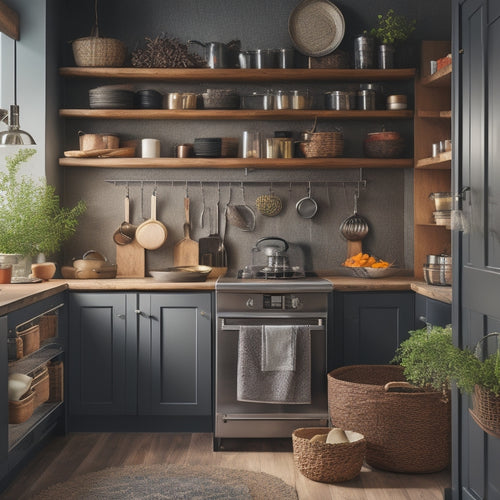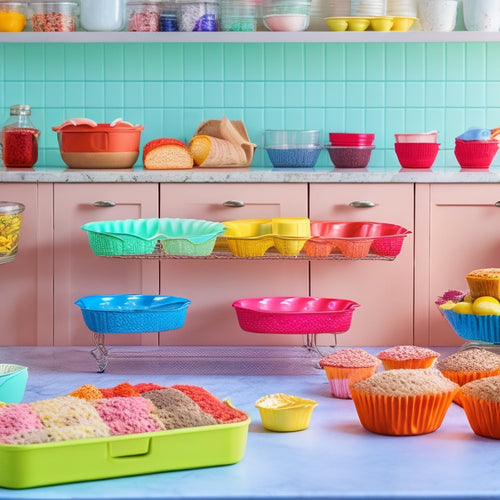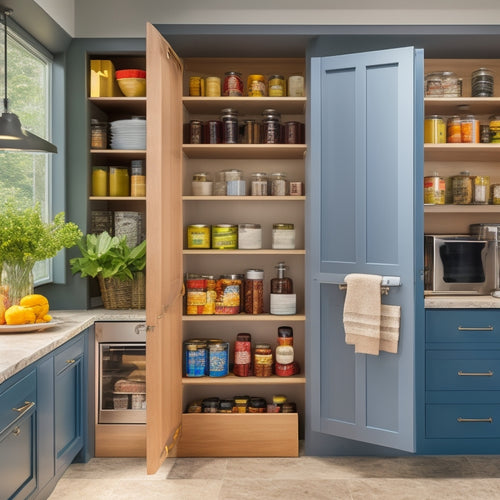
What's Holding You Back From a Clutter-Free Kitchen?
Share
You're stuck in a cycle of clutter and disorganization in your kitchen, and it's not because you're lazy or lack motivation, but because you're likely battling a combination of common obstacles. Perhaps you're holding onto items "just in case," or maybe you lack designated storage spaces, leading to frequent kitchen clutter. Inefficient meal prep habits, disorganized countertops, and cabinets, as well as insufficient pantry organization, may also be contributing to the chaos. Limited budgets for renovations, unhealthy attachments to kitchen items, and inadequate cleaning schedules only add to the challenge. Identify and tackle these culprits, and you'll be well on your way to a clutter-free kitchen.
Key Takeaways
• A 'just in case' mentality and emotional attachment to items can prevent you from letting go of clutter and achieving a clutter-free kitchen.
• Lack of designated storage spaces and inefficient use of vertical space can contribute to a cluttered kitchen.
• Inefficient meal prep habits, such as poor time management and ineffective meal planning, can lead to kitchen clutter.
• Failure to implement decluttering strategies, such as purging and categorizing items, can hold you back from a clutter-free kitchen.
• Unrealistic expectations and perfection pressure can hinder progress towards a clutter-free kitchen, making it essential to set realistic decluttering goals.
Kitchen Clutter Culprits Revealed
Your kitchen countertops are likely overrun with gadgets, gizmos, and doohickeys that promise to simplify food prep but ultimately create more clutter. These clutter triggers can make your kitchen feel chaotic, overwhelming, and even unsafe.
It's time to identify the culprits behind your kitchen clutter and develop effective decluttering strategies to take back control. One common clutter trigger is the 'just in case' mentality, where you hold onto items thinking you might need them someday.
Another trigger is the lack of designated storage spaces, leading to a buildup of items on countertops. Additionally, frequent cooking and baking can generate clutter, making it essential to establish habits for cleaning as you go.
To overcome these clutter triggers, implement decluttering strategies like the 'one in, one out' rule, where you get rid of an old item every time you bring a new one into your kitchen. Designate specific zones for food prep, cooking, and storage to maintain organization.
Lacking Storage Space Solutions
Now that you've identified the kitchen clutter culprits, it's time to tackle the issue of lacking storage space.
You'll be happy to know that there are simple and effective solutions to maximize your kitchen's storage potential.
Optimizing Cabinet Real Estate
Maximizing the storage potential of your cabinets is pivotal, as cluttered kitchens often stem from inefficient use of this prime real estate. You can't afford to waste a single inch of space, especially when it comes to storing essentials like pots, pans, utensils, and dishes.
To optimize your cabinet space, consider the following strategies:
-
Purge and categorize: Get rid of items you no longer need or use, and group similar items together to make the most of your cabinet space.
-
Use adjustable shelves and dividers: These will help you create customized storage solutions that adapt to your changing needs.
-
Install pull-out drawers or baskets: These make it easy to access items at the back of your cabinets, reducing clutter and making meal prep a breeze.
Utilizing Vertical Space Effectively
Tall cabinets and high ceilings offer a wealth of untapped storage potential, and learning to harness this vertical space can be a game-changer for kitchens struggling to stay organized. By utilizing your kitchen's vertical space effectively, you can free up countertops and create a more streamlined cooking environment.
One way to do this is by installing hanging baskets or shelves above your countertops. These can be used to store infrequently used items, such as special occasion dishes or cookbooks, keeping them out of the way but still easily accessible.
Another option is to install pot racks, which can hang from the ceiling or a wall, providing a convenient place to store pots, pans, and utensils.
Disorganized Countertops and Cabinets
Your countertops and cabinets, once intended to be hubs of efficiency, have devolved into cluttered chaos, making meal prep a frustrating obstacle course. You're not alone in this struggle, but it's time to take back control and create a clutter-free kitchen that sparks joy.
To get started, focus on these essential steps:
-
Purge and declutter: Remove everything from your countertops and cabinets, and sort items into categories. Be ruthless – if you haven't used it in the past year, it's likely taking up valuable space.
-
Assign a home: Once you've purged your items, assign a designated spot for each one. This will help maintain organization and make it easier to find what you need when you need it.
-
Utilize functional storage: Invest in functional kitchen storage solutions like baskets, bins, and drawer dividers to keep items organized and out of sight.
Inefficient Meal Prep Habits
When you're struggling to prepare meals efficiently, it's often because you're not working with a clear plan. You might be skipping meal prep schedules, neglecting to use planning tools, or dealing with a disorganized kitchen layout that slows you down.
Meal Prep Schedules
By relying on vague intentions rather than a structured plan, you're likely setting yourself up for meal prep failure, with wasted time and resources being the ultimate consequences.
Without a clear schedule, you'll find yourself scrambling to decide what to cook, leading to last-minute takeout orders and a cluttered kitchen.
To avoid this, establish a meal prep schedule that works for you. This will help you:
-
Manage your time effectively, allocating specific days and times for meal prep, cooking, and cleaning.
-
Optimize ingredient storage, ensuring you use up perishable items before they expire and reducing food waste.
-
Streamline your cooking process, allowing you to prepare healthy, delicious meals in no time.
Lack of Planning Tools
Relying on mental reminders and scraps of paper to plan your meals often leads to inefficient meal prep habits, causing you to forget crucial ingredients or overlook nutritional balance. This lack of planning tools can lead to meal prep chaos, making it challenging to maintain a clutter-free kitchen.
To overcome this, investing in effective meal planning and organization tools is crucial. Consider using a digital meal planning app or a physical planner specifically designed for meal prep. These tools allow you to plan your meals in advance, keep track of ingredients, and ensure nutritional balance.
With a clear plan in place, you can make a grocery list, shop smart, and prep meals efficiently. This structured approach will help you stay on top of meal prep, reducing stress and clutter in the kitchen.
Disorganized Kitchen Layout
A disorganized kitchen layout can significantly impede your meal prep efficiency, leading to wastage of valuable time searching for utensils, ingredients, or cooking tools amidst the clutter. This inefficiency can result in irritation, pressure, and even accidents in the kitchen. To overcome this challenge, optimizing your kitchen layout for meal prep success is crucial.
Here are three ways to achieve this:
-
Clear kitchen counter mess: Allocate a specific area for food preparation, and keep regularly used items within easy reach. This will aid in maintaining focus and avoiding interruptions.
-
Enhance pantry arrangement: Allocate a spot for each pantry item and group similar items together. This will save time and minimize the chances of expired or spoiled ingredients.
-
Simplify your cooking area: Place your cooking tools and utensils close to the cooking surface, and consider investing in a utensil organizer or spice rack. This will assist in remaining efficient and secure during cooking.
Insufficient Pantry Organization
Frequently, you open your pantry door only to be greeted by a jumbled mess of expired cans, crumbling snacks, and mystery containers, making it nearly impossible to find what you need when you need it. This chaotic scene is often a result of insufficient pantry organization, which can lead to food waste, meal prep delays, and even safety hazards like pest infestations or expired food consumption.
To tackle this issue, you need a solid pantry organization system. Implementing a labeling system can help you quickly identify what's inside containers and on shelves, saving you time and reducing frustration. Assign categories like 'baking supplies' or 'canned goods' to specific shelves or bins, and use labels to indicate contents and expiration dates.
Container solutions like baskets, bins, and canisters can also help keep similar items together and prevent clutter from building up. By investing time and effort into organizing your pantry, you'll be able to maintain a safe, efficient, and clutter-free kitchen space that supports your cooking needs.
Forgotten Kitchen Zones
Your kitchen's 'dead zones' – the areas behind appliances, beneath cabinets, and inside deep drawers – often become black holes for kitchen essentials, making them difficult to access when you need them most. These forgotten kitchen zones can lead to clutter buildup, making your kitchen feel disorganized and stressful.
To reclaim these areas, start by identifying the hidden spaces in your kitchen. Here are three key areas to focus on:
-
Overlooked pantry: Check the back of your pantry shelves for expired or unused items. Consider installing a lazy Susan or a pull-out storage unit to make the most of this space.
-
Neglected drawers: Open your deepest drawers and sort through their contents. Discard broken or unnecessary items, and organize the rest using dividers or inserts.
-
Behind appliances: Clean out the areas behind your appliances, such as the refrigerator or oven, and store infrequently used items like specialty cookware or baking sheets.
Limited Budget for Renovations
As you set out on creating a clutter-free kitchen, you're likely facing a common obstacle: a limited budget for renovations. Don't let this constraint hold you back, as there are creative ways to achieve your goals without breaking the bank.
Affordable Storage Solutions
Opting for creative repurposing, you can transform everyday items into functional storage solutions, maximizing your kitchen's organizational potential without breaking the bank. This approach not only saves you money but also reduces waste and promotes sustainability.
Here are three affordable storage solutions to get you started:
-
Space-saving baskets:
Use wicker or fabric baskets to store dry goods, spices, or cleaning supplies. Label each basket to ensure convenient identification and accessibility. -
Budget-friendly shelves:
Install floating shelves or repurpose old bookshelves to create additional storage for cookbooks, kitchen gadgets, or decorative items. -
Repurposed containers:
Transform old jars, canisters, or tins into storage containers for coffee, tea, or spices. This will add a touch of personality to your kitchen while keeping essentials within reach.
DIY Renovation Hacks
With a limited budget for renovations, you can still give your kitchen a fresh new look by employing clever DIY hacks that won't break the bank. One of the most effective ways to achieve this is by focusing on budget-friendly upgrades that can make a significant impact.
| Upgrade | Cost | Impact |
|---|---|---|
| Painting the walls | $100-$300 | High |
| Replacing lighting fixtures | $50-$200 | Medium |
| Adding decorative trim | $20-$100 | Low |
Prioritizing Essential Upgrades
When working with a limited budget, you must strategically prioritize essential upgrades that will yield the most significant return on your investment and transform your kitchen into a clutter-free oasis.
To maximize your budget, focus on upgrades that address functional and aesthetic concerns. Consider the following essential upgrades:
-
Essential Appliance Upgrades: Replace outdated or inefficient appliances with new, energy-efficient models that won't only enhance your kitchen's functionality but also reduce energy consumption and save you money in the long run.
-
Functional Layout Upgrades: Optimize your kitchen's layout to improve workflow and reduce clutter. This may involve reconfiguring your cabinetry, countertops, or sink placement to create a more efficient and organized space.
-
Task-Oriented Lighting Upgrades: Improve lighting in key areas, such as under-cabinet lighting or pendant lights above the island, to create a brighter, more inviting atmosphere that makes food preparation and cleanup a breeze.
Unhealthy Attachments to Kitchen Items
You've likely amassed a collection of kitchen gadgets and tools over the years, each one evoking memories of a special recipe, occasion, or person. This nostalgic attachment can make it challenging to part with items that no longer serve a purpose, leading to emotional clutter in your kitchen.
Recognizing when these attachments are hindering you from a clutter-free space is crucial. Take a closer look at your kitchen items and ask yourself if they bring you joy or serve a functional purpose. Be honest – if the answer is no, it's time to let go.
Holding onto items out of sentimentality can result in a cluttered kitchen, making meal prep and cooking more stressful. By releasing these emotional connections, you'll create a more streamlined and efficient kitchen that sparks joy and creativity.
Inadequate Cleaning Schedules
Inconsistent cleaning habits and overlooked areas can quickly turn your kitchen into a breeding ground for bacteria, dust, and dirt. This is a common decluttering dilemma that can be tackled by establishing a regular cleaning schedule. You may think you're saving time by skipping daily cleaning tasks, but prioritizing cleaning consistency is crucial to maintain a clutter-free kitchen.
Here are three ways to improve your cleaning schedule:
-
Allocate 10-15 minutes each day to quickly wipe down countertops, sinks, and faucets, and sweep/vacuum floors.
-
Assign specific days for deeper cleaning tasks, such as cleaning the oven, refrigerator, or dishwasher.
-
Develop a monthly cleaning calendar to stay on top of tasks like cleaning out the pantry, dusting ceiling fans, or organizing kitchen cabinets.
Unrealistic Expectations for Perfection
Having unrealistic expectations of a perfectly organized kitchen can lead to frustration, disappointment, and a sense of failure, causing you to give up on your decluttering efforts altogether. You may feel pressure to achieve a Pinterest-perfect kitchen, but this perfection pressure can be overwhelming. It's essential to recognize that a clutter-free kitchen is a process, not a one-time achievement.
| Unrealistic Expectations | Realistic Goals |
|---|---|
| A spotless kitchen at all times | A kitchen that's organized and functional most of the time |
| Every item has its perfect place | Most items have a designated spot, with some flexibility |
| No clutter or mess ever | A manageable amount of clutter, with a plan to tackle it regularly |
| Perfection in every area | Progress in most areas, with some areas still a work in progress |
Letting go of perfection and focusing on progress over perfection can be incredibly liberating. By accepting that your kitchen will never be perfect, you can focus on making progress towards a more organized and functional space. Practice self-acceptance and acknowledge that it's okay to have some imperfections. Remember, a clutter-free kitchen is a journey, not a destination.
Frequently Asked Questions
Can I Still Have a Clutter-Free Kitchen With a Small Budget?
You can achieve a clutter-free kitchen on a small budget by implementing budget-friendly organization strategies, like repurposing items and utilizing small space solutions, along with creative storage and DIY decluttering techniques that prioritize functionality and safety.
How Do I Declutter Sentimental Kitchen Items From My Childhood?
You're struggling to part with sentimental kitchen items from your childhood, but adopting a minimalist approach can help. Consider displaying a few cherished childhood keepsakes, while storing others in practical storage solutions, allowing you to cherish memories without clutter.
What's the Best Way to Organize Kitchen Utensils With Limited Drawer Space?
You're optimizing kitchen utensil storage with limited drawer space! Consider vertical storage options like wall-mounted rails or hooks, and invest in multi-functional tools that serve multiple purposes, ensuring a safe and clutter-free cooking environment.
Can a Clutter-Free Kitchen Really Improve My Mental Health?
Did you know 72% of adults experience anxiety daily? You can find stress relief in a clutter-free kitchen, where organization and cleanliness promote mental health. By creating a peaceful space, you'll reduce anxiety and boost overall well-being.
How Often Should I Deep Clean My Kitchen to Maintain a Clutter-Free Space?
You should aim to perform weekly maintenance tasks, like wiping down surfaces and tidying up, and schedule seasonal deep cleans to maintain a clutter-free kitchen; quick decluttering strategies, like the "one-touch rule," can also help.
Related Posts
-

Over-The-Door Kitchen Storage for Apartment Living
Over-the-door kitchen storage is a smart solution for apartment living, allowing you to maximize vertical space while...
-

Roll-Out Trays for Organizing Baking Supplies
Roll-out trays are perfect for organizing your baking supplies, making your kitchen more efficient. They maximize spa...
-

Affordable Sliding Pantry Drawer Solutions
If you're looking for affordable sliding pantry drawer solutions, you're in the right place. These drawers maximize s...


